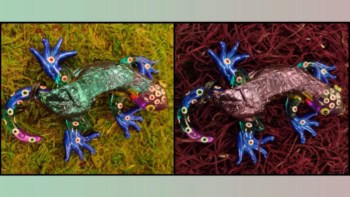In the pursuit of environmentally-friendly lighting, organic LEDs have long been touted as an attractive option. They could be significantly more efficient than conventional lighting and unlike fluorescent tubing they don’t contain toxic mercury. Now, researchers in Germany have created the first LED from organic materials that is more efficient than traditional lighting.
Light emitting diodes emit monochromatic light when their electrons combine with holes to form “excitons”. Standard LEDs made from inorganic materials have already found widespread application in screens and commercial lighting because of their high efficiency. For example, the Water Cube swimming arena at last summer’s Beijing Olympics used nearly half a million red, green and blue LEDs.
In recent years researchers have also started to develop a new wave of LEDs using organic materials such as polymers. As well as being eco-friendly to dispose of, these LEDs also have the advantage of generating photons across a range of colours resulting in white light. Now, a team of physicists have redesigned the internal structure of organic LEDs to produce significantly brighter white light.
Bright lights
“It is clear that novel light sources, like organic LEDs, should have an efficiency as high as possible, since lighting uses significant parts of the electricity consumed in buildings — 22 percent in the US,” said Karl Leo, one of the researchers at the University of Dresden.
One promising way of creating white light is to coat an LED with phosphor, which converts monochromatic light into red, green and blue light. The drawback until now has been a lack of efficiency; 80 percent of the photons generated remain trapped in the LED emission substrate and the surrounding phosphor.
Leo and his team have overcome this problem by optimizing the coupling between these phosphor and polymer layers. By integrating blue, green and red phosphor into the heart of the emission layer, they have created a system that allows significantly more photons to escape.
Efficiency matters
Standard fluorescent tubes generate light with a power efficiency of 60-70 lumens per Watt but until now the most organic LEDs had an efficiency of just 44 lumens per Watt. Publishing their findings in Nature, the team from Dresden report a power efficiency of 90 lumens per Watt, with a potential maximum of 124.
“This is a benchmark because it would be good to replace all fluorescent tubes and compact fluorescent lamps in the world with a more environmentally friendly light source,” said Colin Humphreys, the Goldsmiths Professor of Materials Science at Cambridge University.
However, Humphreys also warned about the economic aspects that need to be developed. “For panel lighting, at the present time it is cheaper to use a matrix of inorganic LEDs based on gallium nitride behind a diffusing panel,” he said.
Leo told physicsworld.com that his team are working closely with their spin-off company Novaled AF to further develop both the quality of light and the energy efficiency. “We would like to test deeper blue emitters, to avoid the somewhat yellow colour coordinates we have now,” he said.



